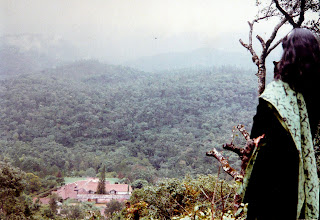Nostalgic memories
 Statue of the Maharajah
Statue of the MaharajahAnyone born in Kerala and who has gone away from its shores for employment and a living has many lingering memories of the land in his mind. Of these, the memories connected with the ancestral family, the village, the childhood, the harvest festivals and the worshipping places are most rooted. Probably, this is because these institutions or symbols have considerably shaped ones personality and thoughts during one’s formative years.
Temple festivals of yore were occasions when village children in particular enjoyed themselves wholeheartedly. The hawkers with wares unseen, vendors of exotic sweets, performers of magic tricks, performances like Ottan thullal, Chenda melam with its mystic and captivating tones and the caparisoned elephants provided enough thrill and excitements to the young minds. Money was hard to come by, but the enthusiasm was never diminished. Snacks from the make-shift stalls tasted heavenly.
As one grew up, the colours of many memories faded. Still, the Kathakali performances seen with sleep-filled eyes and the sight of the procession of family members back to home in the wee hours of the morning are images strongly left in the mind.
Ezhunnellippu, the divine procession
The temple festival at the Poornathrayeesa temple during the first week of December brought back many memories of my childhood. We stay in the Fort area adjacent to the temple. I have grown to be less religious. I am now more interested in spirituality and philosophy which cross the boundaries of every known dimension invented by man. However, I respect tradition and love all the art forms which were greatly encouraged by our forefathers. So, an occasional trip to the temple precincts with cameras was always memorable. My SLR camera with lenses had been gifted to Lavanya, my daughter who has since proceeded to the Nottingham University and I am left with only digital compact cameras and the Digicam. She does a very good job with the camera and I have no regrets. The thrill of still photography comes only with a SLR camera, I feel.
Thayampaka, the orchestra.

Majesty, the caparisoned elephant
 Pancharimelam, the orchestra
Pancharimelam, the orchestra Seeveli procession
Seeveli procession There were about 16 elephants brought to the confines of the temple compound. The caparisoned elephants provided a beautiful sight indeed. But I wonder if we need to continue with the tradition of bringing elephants for the festivals. These mammoth animals are not intended for such occasions. They are best left in the jungles or game parks so that generations to follow will praise our compassion and understanding to these gentle animals of unique proportions.
As always, the ending of every festival brings in a gloom. But soon, at another place, another festival begins. The performers move to their next destination with all their paraphernalia along with the bundles of their Karma!
Now, comes X’mas! A very merry Christmas and a very happy new year to all!
Fort, Tripunithura,
South India.
19th December 2010





Comments
Above all these are the occations we meet our beloved ones together.
Thanks for posting this...
Merry Christmas & I wish you a happy and a prosperous new year!!!
Kind regards,
I have wondered how temples became the centers of spiritual, cultural and even commercial activities (remember the commerce that happened on the AluvA maNappuRam?)in KEraLam. In SriLanks, where the Buddhists took over, I have read, by the 4th century AD, 80% of the land had come under the vihara-s. So my question is: Did the temple organizers follow such a model and made the temple the center of all types of activities giving people spiritual support, teaching ethical lessons, entertaining them, giving them support economically in times of need through free food, etc.? For me, growing up, the early niRmmAlya daRSanam was a mystical experience. I did not like festivals, but I adored the artistic presentations. Hated the fireworks, was afraid of the elephants running amok, but all those shortcomings fade when I think of the KathakaLi, the musical concerts, the Koottu^ and PAtTHakam presentations, etc. I know there are dark sides to the temple culture, such as the feelings of those who were excluded, the intermural fighting between tekkummuRi and the vaTakkummuRi (sometimes healthy and at other times debilitating competition) etc. But for many, the temples were centers of solace, even psychological healing. It is interesting that in KEraLam, now, there are conflicts going on centered around temples among political parties partly, I imagine, because of their wealth and partly because of their potential to be used to influence people. In Europe, the power of the church has all but disappeared, but in parts of the US, the Church is a powerhouse. Although I believe in religious liberty, I wish a TOTAL separation of religion and politics could be made REAL. I think those are territories that need no mixing! I know my position is utopian. Witness the events in France, where the extremists dragging the State into fields of religion! Macron is deporting hardline clerics and closing mosques that preach violence. I wish there were an end to this irrational atavism!
DKM